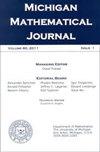Uniqueness in Haken’s Theorem
IF 0.6
3区 数学
Q2 MATHEMATICS
引用次数: 2
Abstract
Following Haken and Casson-Gordon, it was shown in [Sc] that given a reducing sphere or boundary-reducing disk S in a Heegaard split manifold M in which every sphere separates, the Heegaard surface T can be isotoped so that it intersects S in a single circle. Here we show that when this is achieved by two different positionings of T, one can be moved to the other by a sequence of 1) isotopies of T rel S 2) pushing a stabilizing pair of T through S and 3) eyegelass twists of T. The last move is inspired by one of Powell's proposed generators for the Goeritz group.哈肯定理的唯一性
继Haken和Casson-Gordon之后,在[Sc]中表明,给定Heegaard分裂流形M中每个球体分离的还原球或边界还原盘S, Heegaard曲面T可以被同位素化,使其与S相交成一个圆。在这里,我们表明,当T的两个不同位置实现这一目标时,一个可以通过一系列的方式移动到另一个:1)T的同位素S, 2)推动稳定的T对通过S, 3) T的眼镜状扭曲。最后一个移动的灵感来自鲍威尔提出的Goeritz组的发电机之一。
本文章由计算机程序翻译,如有差异,请以英文原文为准。
求助全文
约1分钟内获得全文
求助全文
来源期刊
CiteScore
1.20
自引率
11.10%
发文量
50
审稿时长
>12 weeks
期刊介绍:
The Michigan Mathematical Journal is available electronically through the Project Euclid web site. The electronic version is available free to all paid subscribers. The Journal must receive from institutional subscribers a list of Internet Protocol Addresses in order for members of their institutions to have access to the online version of the Journal.

 求助内容:
求助内容: 应助结果提醒方式:
应助结果提醒方式:


